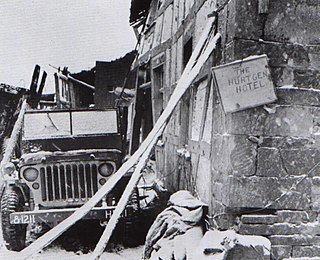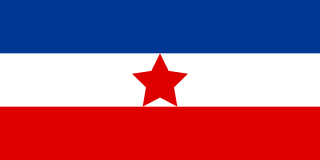
The Battle of Hürtgen Forest was a series of battles fought from 19 September to 16 December 1944, between American and German forces on the Western Front during World War II, in the Hürtgen Forest, a 140 km2 (54 sq mi) area about 5 km (3.1 mi) east of the Belgian–German border. Lasting 88 days, it was the longest battle on German ground during World War II and is the second longest single battle the U.S. Army has ever fought after the four-day-longer Battle of Bataan.

Case White, also known as the Fourth Enemy Offensive, was a combined Axis strategic offensive launched against the Yugoslav Partisans throughout occupied Yugoslavia during World War II. It was one of the most significant confrontations of World War II in Yugoslavia. The offensive took place in early 1943, between 20 January and mid-to-late March. The Axis operation prompted the Partisan Supreme Command to enact its plans to drive toward eastern Herzegovina, Sandžak and Montenegro.

The Serb Volunteer Guard was a Serbian volunteer paramilitary unit, founded and led by Željko Ražnatović. It fought in the Croatian War and the Bosnian War during the Yugoslav Wars, and was responsible for numerous war crimes and massacres.

The Una is a border river between Bosnia and Herzegovina and Croatia and a right tributary of the Sava river. It is part of the Black Sea drainage basin, and its watershed has a size of 10,200 km2 (3,900 sq mi), of which 8,080 km2 (3,120 sq mi) belongs to Bosnia and Herzegovina, and 2,120 km2 (820 sq mi) to Croatia. The total length of the river is 212 km (132 mi). The source of the river is located near the village of Donja Suvaja in Croatia, and its mouth is located near the village of Jasenovac, on the border with Bosnia. The largest right tributaries are the Krka, Unac, Krušnica and Sana rivers, and the largest left tributary is the Klokot river. Its longest headwater is the Unac river. The largest and most important city located on the river is Bihać. Other, important cities and towns are Bosanska Krupa, Bosanski Novi and Bosanska Kostajnica. The river is characterized by a multitude of waterfalls, rapids, karst springs and relatively untouched nature. A large part of the upper river is part of the Una National Park.

Sanski Most is a town and municipality located in the Una-Sana Canton of the Federation of Bosnia and Herzegovina, an entity of Bosnia and Herzegovina. It is situated on the banks of the Sana River in northwestern Bosnia and Herzegovina, in the region of Bosanska Krajina, between Prijedor and Ključ. As of 2013, it has a population of 41,475 inhabitants.

Operation Rösselsprung was a combined airborne and ground assault by the German XV Mountain Corps and collaborationist forces on the Supreme Headquarters of the Yugoslav Partisans in the Bosnian town of Drvar in the Independent State of Croatia during World War II. It was launched 25 May 1944, with the goal of capturing or killing Partisan leader Marshal Josip Broz Tito and destroying the headquarters, support facilities and co-located Allied military missions. It is associated with the Seventh Enemy Offensive in Yugoslav history, forming part of the Seven Enemy Offensives historiographical framework. The airborne assault itself is also known as the Raid on Drvar.

Ključ is a town and municipality located in the Una-Sana Canton of the Federation of Bosnia and Herzegovina, an entity of Bosnia and Herzegovina. The name of the town and the municipality translates to "Key" in English.
Atif Dudaković is a retired Bosniak general who served in the Army of Republic of Bosnia and Herzegovina. During the Bosnian War, Dudaković was in command of the Bihać enclave, which was surrounded and besieged from 1992 to 1995, commanding the 5th Corps. After the war he became the general commander of the Army of the Federation of Bosnia and Herzegovina. In 2018, he was charged with war crimes.
Operation Sana was the final military offensive of the Army of the Republic of Bosnia and Herzegovina in western Bosnia and Herzegovina and the last major battle of the Bosnian War. It was launched from the area of Bihać on 13 September 1995, against the Army of Republika Srpska, and involved advances towards Bosanski Petrovac, Sanski Most and Bosanska Krupa. At the same time, the Croatian Army and the Croatian Defence Council were engaging the VRS in Operation Maestral 2 further to the southeast. After an initial 70-kilometre (43 mi) advance, VRS reinforcements managed to stop the ARBiH short of Sanski Most and Bosanski Novi, and reversed some of the ARBiH's territorial gains in a counterattack. After a part of the ARBiH 5th Corps was threatened with defeat around the town of Ključ, the ARBiH requested assistance from the HV.

The 5th Corps was one of seven corps and smallest one of the Army of the Republic of Bosnia and Herzegovina. The formation was around the Bihać pocket to protect it against the surrounding Serb forces. The Fifth Corps also fought secessional Bosniak forces loyal to Fikret Abdić, who was cooperating with Serb forces. Just days before the last 5th Corps military operation, Operation Sana, 5th Corps defeated Abdić's army and supporters bringing the rouge autonomous province under government's control in the Downfall of Second autonomy operation. After that 5th Corps started all out offensive Operation Sana, connecting to the rest of the Bosnian territory while bringing a number of previously lost and occupied regions of Bosnia and Herzegovina under government control, defeating 1st and 2nd Krajiški corps, strengthened with units that escaped Kninska krajina and multiple serb paramilitary forces coming to aid from different forntlines. During Sana 95 and Downfall of Second autonomy 5th Corps also liberated towns and communes in border section of Croatia. Connecting with Croat forces in Grabovac-Rakovica area, Korenica-Frkašić area, Bogovolja-Cetingrad area and on a overlooking hill west of Plitvička jezera. The solemny meet up was done on the border bridge in Tražačka Raštela, where commanders of both countries shook hands. During the Operation Sana 95 5th Corps captured biggest war loot the ARBiH ever had. Inventory of ARBiH weaponry grew exponentially after Operation Sana 95 which equipped the unit for further Operation Prijedor 95. In April 2018, police detained Atif Dudaković and 12 others on suspicion of committing crimes against humanity during the Bosnian war. The court process is still ongoing without any established evidence.

The siege of Bihać was a three-year-long siege of the northwestern Bosnian town of Bihać by the Army of the Republika Srpska, the Army of the Republic of Serbian Krajina and Bosnian Muslim dissenters led by Fikret Abdić during the 1992–95 Bosnian War. The siege lasted for three years, from June 1992 until 4–5 August 1995, when Operation Storm ended it after the Croatian Army (HV) overran the rebel Serbs in Croatia and northwest of the besieged town.

The 373rd (Croatian) Infantry Division was a division of the German Army during World War II. It was formed in June 1943 using a brigade from the Home Guard of the Independent State of Croatia with the addition of a German cadre. The division was commanded by Germans down to battalion and even company level in nearly all cases, and was commonly referred to as a "legionnaire division". Originally formed with the intention of service on the Eastern Front, it was used instead for anti-Partisan operations in the territory of the NDH until the end of the war. It fought mainly in the western areas of the NDH, and was involved in the attempt to kill or capture the leader of the Partisans, Josip Broz Tito, in May 1944. Severely depleted by desertion, the division withdrew towards the Reich border in the early months of 1945, eventually surrendering to the Partisans on 10 May 1945 near Brežice in modern-day Slovenia.

The battle of Knin was a major Yugoslav Partisan operation during World War II in Yugoslavia launched by the 8th Dalmatian Corps from 7 November to 9 December 1944 with the purpose of destroying German, Ustaše and Chetnik formations in North Dalmatia and the city of Knin, then part of the Independent State of Croatia. It was the final part of the 8th Corps offensive for the liberation of Dalmatia which began on 12 September 1944. The Knin operation had three phases: Initial battles on approaches to Knin from 7 November to 25 November, main battle and liberation of Knin from 26 November to 4 December, and final battles and pursuit of retreating Axis forces to Otrić in Lika from 5 December to 9 December.
The May 1941 Sanski Most revolt occurred near the town of Sanski Most in what was at the time Axis-occupied Yugoslavia. The Serb population revolted against oppression by the Ustaše regime, the rulers of the Independent State of Croatia who were sponsored by Nazi Germany. Many civilians died during the three days of hostilities.
Operation Southern Move was the final Croatian Army (HV) and Croatian Defence Council (HVO) offensive of the Bosnian War. It took place in western Bosnia and Herzegovina on 8–11 October 1995. Its goal was to help the Army of the Republic of Bosnia and Herzegovina (ARBiH) whose positions around the town of Ključ, captured by them during Operation Sana, were endangered by a counteroffensive by the Army of Republika Srpska (VRS). The objectives of Operation Southern Move included the capture of the town of Mrkonjić Grad and positions on the Manjača Mountain which would allow the HV and the HVO to directly threaten Banja Luka, the largest city controlled by Bosnian Serbs. Finally, the offensive was also aimed at capturing the Bočac Hydroelectric Power Station, the last significant source of electricity under VRS control in western Bosnia and Herzegovina. The combined HV and HVO forces were under the overall command of HV Major General Ante Gotovina.
Operation Bura was a joint offensive conducted by the Croatian Defence Council and the Croatian Army on the territories held by the Nevesinje and Bileća brigades of the Army of Republika Srpska during the Bosnian War.

The Bihać operation was a military operation conducted by Yugoslav partisans against the Independent State of Croatia (NDH) and Nazi Germany during World War II. The aim of the operation was to capture Bihać and the surrounding towns to connect Partisan held areas in Bosanska Krajina, and Knisnka Krajina. The battle for the city of Bihać lasted from 2 November to 4 November 1942. After capturing the city, the partisans continued to fight in surrounding areas until 15 November. The operation resulted in a major Partisan victory, with Bihać and the surrounding areas being captured, and the NDH suffering significant casualties.

The 5th Krajina Division was a Yugoslav Partisan division formed in Glamočko polje on 9 November 1942.

Operation "Breza 94" was the official codename for the military offensive conducted by the 1st Krajina Corps of the VRS in September 1994 in Bosanska Krajina. The objective of the offensive was the breaking of the 5th Corps and the conquest of Bosanska Krajina. The offensive ended in VRS defeat with the ARBiH capturing 20 square kilometers previously held by Serbs.
Operation Bosanska Krajina was the code name of the Army of Republika Srpska (VRS) offensive during the Bosnian War which aimed to capture the municipalities of Prijedor, Sanski Most and Ključ. The offensive was also the response of the VRS to the Army of the Republic of Bosnia and Herzegovina (ARBiH) attack on the city of Prijedor. The operation ended with the victory of the VRS and the beginning of the siege of Bihać.













